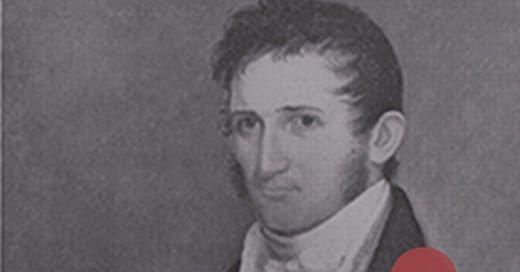Welcome back to the This Day newsletter. Each week, a member of our team gathers together bits of America’s past and attempts to find a throughline that might add a little understanding to our current moment.
We’re switching up our format this week (let me know what you think!). We’ve still got a fascinating list of historical moments to share, plus some episodes we’ve done already, but first, a quick-hits rundown of some historical thoughts from a member of our team, starting with researcher Jacob Feldman…
One thing I’m reminded of this week:
There are still lots of unresolved questions about Joe Biden’s cancer diagnosis and the impact the disease might have had on him as President. We’ve talked a lot on the show about past POTUS’ health issues, and the degree to which they’ve hid those problems from the public, going back to when President Grover Cleveland disappeared to a yacht for four days in 1893 to have a tumor removed from his mouth. Woodrow Wilson later suffered a stroke during his last year in office, but largely concealed its effects from the public. They had a reason for doing so, obviously; when news broke that President Eisenhower had suffered a heart attack, the Dow Jones saw its worst day since the start of World War II.
One thing I learned this week:
I’ve been tearing through The Rise and Fall of the Second American Republic by Manisha Sinha, which retraces American Reconstruction while expanding that story beyond questions of Southern racism to include “the US Army's conquest of Indigenous nations in the West, labor conflict in the North, Chinese exclusion, women's suffrage, and the establishment of an overseas American empire” as part of the same arc. Fascinating stuff. One tangent involves Abraham Lincoln’s push to resettle Black Americans, including a failed attempt to move 453 freed people to a Haitian island.
One thing history will remember this week:
“Arguably the most significant piece of Legislation that will ever be signed in the History of our Country!” aside, I think the Trump administration’s continued assault on America’s elite universities will be the most significant storyline from this week. Yesterday, the government halted Harvard’s ability to enroll international students. We actually have an episode scheduled on a topic related to the messy intersection of geopolitics and academia coming up; something tells me it will still feel topical when we tackle it in a couple weeks.
One other thing I want to say this week:
Thanks again to
for coming on this week to talk MecDec Day.If you’re a fan of esoterica (and you’re here, aren’t you?), check out his great newsletter, even if you’re not from NC! He posted some more great MecDec color this week.
Here’s what happened over the week ahead in American political history…
May 23
1846: President Mariano Paredes of Mexico unofficially declares war on the United States
1909: Helen “Nellie” Taft, wife of President William Howard Taft, suffers a stroke that causes her to retreat from the White House to recover
1934: Infamous American bank robbers Bonnie Parker and Clyde Barrow are killed in Louisiana
1944: The Texas Democratic Party splits over supporting FDR, with a significant portion calling for the “restoration of states’ rights which have been destroyed by the Communist New Deal” and “restoration of the supremacy of the white race”
May 24
1775: John Hancock becomes President of Congress
1879: William Lloyd Garrison, publisher of the anti-slavery Liberator, dies
1883: The Brooklyn Bridge opens during a ceremony presided over by President Chester A. Arthur and New York Governor Grover Cleveland
May 25
1738: A treaty between Pennsylvania and Maryland ends the Conojocular War
1961: U.S. President John F. Kennedy announces the goal of putting a man on the Moon before the end of the decade
1978: The first of a series of bombings orchestrated by the Unabomber detonates at Northwestern University
May 26
1637: The Pequot Massacres begin: Puritans and their Native allies marched on the Pequot village at Mystic, slaughtering all but a handful of its inhabitants
1868: The Senate impeachment trial of President Andrew Johnson ends with his acquittal
1924: U.S. President Calvin Coolidge signs a law restricting immigration.
1986: “Hands Across America” gathers Americans to line up from coast to coast in order to raise awareness about homelessness and hunger
2009: President Barack Obama nominates federal appeals judge Sonia Sotomayor to be the first Hispanic justice on the Supreme Court
May 27
1937: The Golden Gate Bridge opens for the first time for “Pedestrian Day.” Cars would be allowed starting at noon the following day
1939: The SS St. Louis, carrying Jewish refugees, is turned away from multiple countries, including the US and Canada and forced to return to Europe, where 254 of the passengers would be killed by Nazis
2016: Barack Obama becomes the first president to visit Hiroshima Peace Memorial Park
May 28
1830: President Andrew Jackson signs the Indian Removal Act, authorizing the Army to force Cherokee, Chickasaw, Choctaw, Creek, and Seminole tribes out of Georgia and surrounding states, setting the stage for the Cherokee Trail of Tears
1851: Sojourner Truth prepares her “Ain’t I a Woman” speech. It tells us a lot about how myths are made, and historical figures are flattened over time
1984: On Memorial Day 1984, President Ronald Reagan led a state funeral at Arlington National Cemetery for an unidentified American soldier killed in the Vietnam War
Apple | Spotify | PocketCasts | YouTube | Instagram






